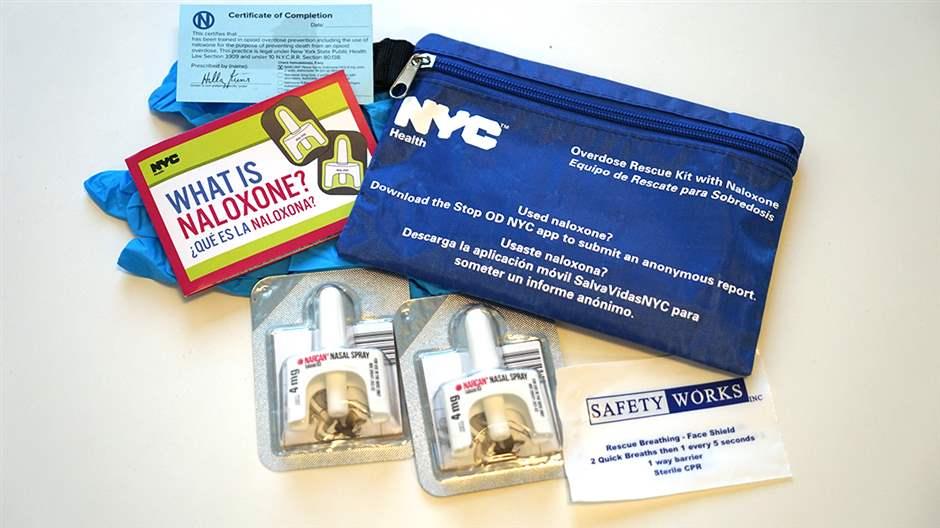
By Christine Vestal, Stateline.
NEW YORK — “Just Say No” — the 1980s anti-drug slogan — doesn’t cut it here at the Brooklyn cabaret House of Yes.
Starting this month, House of Yes and dozens of other bars and nightclubs in the vibrant Williamsburg and Bushwick neighborhoods are handing out coasters and pinning up posters to warn people that the deadly opioid fentanyl might be mixed with their cocaine, and if it is, they could overdose and die.
“We know people are using drugs,” said Allegra Meshuggah, the entertainment venue’s costume director. “We’re not trying to scare them. We just want to save a few lives.”

Nationwide, overdose deaths among cocaine users, many of them occasional, have nearly tripled in the past five years for which data is available, rising from roughly 5,000 deaths in 2013 to more than 14,000 in 2017. The cause is fentanyl, data from the Centers for Disease Control and Prevention shows.
To stanch the death toll from fentanyl contamination in the illicit drug supply in New York City, the Department of Health and Mental Hygiene is working with House of Yes and other bars and clubs to encourage cocaine users to take these precautions when using the drug:
Never use alone, so someone will be there to help you if you overdose. Use a small amount of the drug at first to test for the presence of fentanyl. And make sure someone nearby has the overdose rescue drug naloxone.
Health departments in Pittsburgh, San Francisco and Seattle have similar collaborations with nightlife venues and festivals.
New York’s collaboration with Brooklyn bars and nightclubs launched this month and will continue through August. After that, the health department expects the venues will continue posting fentanyl warnings and stocking naloxone behind the bar in case a patron overdoses. The agency will supply additional naloxone, coasters and other informational materials as needed.
The Brooklyn drug awareness campaign follows a test of the concept last May and June in the Lower East Side of Manhattan, another high-density nightlife area.
Rising Deaths
The spike in cocaine overdose deaths in recent years can be explained in part by an increase in cocaine use. But CDC data also indicates that opioids, including fentanyl, were involved in nearly 70% of the deaths.
Fentanyl’s potency heightens the risk of overdose for people who regularly consume opioid painkillers or heroin. For cocaine users who do not regularly use opioids, the risk of overdose from trace amounts of fentanyl may be even higher, because they are unlikely to have developed a tolerance for opioids, a report by the New York City Bureau of Alcohol and Drug Use Prevention, Care and Treatment found.
In addition, occasional cocaine users who do not regularly use heroin or other illicit drugs are less likely to encounter harm reduction services or sterile syringe programs that routinely hand out naloxone kits and educate drug users about the presence of fentanyl.
Overdoses in bars and nightclubs are rare, the drug bureau report finds. The goal, New York City health research director Denise Paone said, is to help bar and club workers prepare for a potential overdose in their venues and, most important, inform their patrons about the risks of fentanyl and the importance of carrying naloxone.
Training Day
Early on a muggy Tuesday evening in July, hours before the neighborhood’s bars and clubs would start filling up, House of Yes hosted an event sponsored by the health department to warn fellow bar and nightclub workers about the presence of fentanyl in the cocaine supply and to show them how to use naloxone.
On a well-lit, elevated stage normally occupied by burlesque dancers, clowns and other uniquely costumed performance artists, a health department official flipped through slides showing that New York City cocaine users were dying at an alarming rate.

The rate of unintentional drug overdose deaths increased for the seventh consecutive year in the city, from 8.2 per 100,000 residents in 2010 to 21.2 per 100,000 in 2017, when one New Yorker died every six hours from a drug overdose, city health data shows.
Cocaine deaths in the city rose from 326 in 2014 to 732 in 2017. A tally of overdose deaths for 2018 will be available in August.
More than a hundred local nightlife professionals attended an hour-and-a-half presentation that many said they considered essential, life-saving information. “Everyone was really into it,” said House of Yes employee Henri Fox, who recently moved to the city from North Carolina. “I was losing an average of two friends a month to overdoses back in Wilmington. The worst thing we can do is not talk about drug use.”
Excited audience members asked questions throughout the session:
How can I be sure a person has overdosed and hasn’t just passed out? Will naloxone hurt a person who has not taken opioids? Will I be liable for legal charges if I administer naloxone?
The health department’s answers:
- To know whether someone is overdosing, look for blue lips and shallow breathing, and run your knuckles across their breastbone to see whether they wake up.
- No, naloxone will not hurt a person who has not taken opioids. And it won’t hurt anyone taking other drugs or with medical conditions. It is a harmless medication with no side effects.
- No, you won’t be legally liable for administering naloxone.
Most attendees walked away with a free overdose protection kit containing two doses of Narcan, an easy-to-use nasal spray that reverses an opioid overdose. Health department officials said they would supply more kits as needed.
Organized Nightlife
For the health department, reaching out to bars and clubs in the city’s liveliest neighborhoods was a natural. As the number of cocaine overdose deaths involving fentanyl, but not heroin, increased rapidly in 2016 and 2017, the agency hatched its plan.
The association between alcohol consumption and occasional cocaine use was well-established, Paone said. “When we started thinking about that, we realized we really needed to get the message out to people who spend time in bars on the weekends. To get the biggest bang for our buck, we decided to reach out to managers and bartenders and ask them to communicate with their patrons.”
The first time around in Manhattan, the agency’s efforts didn’t go as smoothly. Health department officials, often dreaded by bar and restaurant owners, were showing up unannounced in the late afternoon to talk to bar managers about drug awareness. Fewer than half were interested.
Most bar managers were aware of fentanyl, and a few had heard of naloxone, but none of the bars that participated had previously kept the life-saving drug on the premises, a health department review found.
“What was new here in Brooklyn this time is that we partnered with a neighborhood nightlife association that’s helping us do the outreach and identify venues like House of Yes with larger spaces to do hundred-person trainings,” said Kendall LaSane, a health department epidemiologist who attended the training at the Brooklyn club.
David Rosen, co-founder of Brooklyn Allied Bars & Restaurants, said the overdose prevention program fit right into the goals of his organization. The group previously worked on a public safety awareness campaign with the police precinct to inform young women, many of whom were new to the city, about how to protect themselves from potential predators.
“A lot of it is very personal,” Rosen said. “We’ve known each other for years here in North Brooklyn, and we’ve built strong networks. We’re hyperlocal.”
House of Yes, which dubs itself a “temple of expression,” has also had a history of community awareness, Meshuggah said. “It’s a big part of what we do.”
On its Instagram feed — which has nearly 80,000 followers — House of Yes offers this message: “COCAINE. Let’s talk about it. No shade, no shame, just information.”


